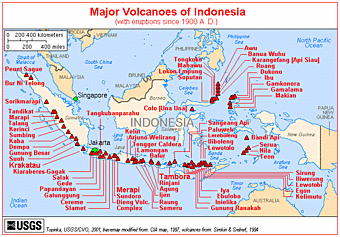Mount Krakatau, Sunda Strait
 At some point in the distant past, Krakatau consisted of a single, large volcanic island. This island was destroyed in eruptions presumably of great violence, leaving three fragments of the original volcanic walls in a broken ring, or caldera, around the edge of this original island. The three islands are now named Rakata, Sertung and Panjang. Subsequently, further eruptions began, building up the largest island (Rakata) back into the center
At some point in the distant past, Krakatau consisted of a single, large volcanic island. This island was destroyed in eruptions presumably of great violence, leaving three fragments of the original volcanic walls in a broken ring, or caldera, around the edge of this original island. The three islands are now named Rakata, Sertung and Panjang. Subsequently, further eruptions began, building up the largest island (Rakata) back into the centerof the caldera. As of 1883, the only previous recorded eruptions had come from this big island in 1680. The islands of Panjang and Sertung, then as now, remained dormant. Then in May of 1883, eruptions began again on the big island, and one by one, the three peaks of the island -- Perboewatan, Danan and Rakata -- each came into action as the cycle of building and destruction reached its peak. Finally, on August 27th, the sequence ended in catastrophe, as huge volumes of ejecta were hurled into the sky, plunging the surrounding region for a radius of 80 km into 57 hours of darkness. Relatively few people appear to have died as a direct result of the ejecta, but huge numbers died because of an indirect consequence of the eruption. As the magma chamber emptied, the outer walls of the volcano failed, and collapsed -- repeating the pre-historic caldera collapse -- displacing two-thirds of the island. These events generated a series of giant waves, or tsunami, which steepened as they reached shallow waters. These waves swept across the coastal lowlands of Java and Sumatra on either side of the Sunda Strait, killing an estimated 36,000 people and destroying many settlements. As an illustration of the forces involved, a government gunboat, the Berouw, was carried nearly 3 km inland and stranded behind a small hill 9 m above sea-level (the crew of 28 were amongst those who died). The violence ended abruptly, leaving a greatly re-shaped archipelago. In the centre of the caldera, where there had once been a substantial island, the sea-floor was reached at a depth of over 250 m. The three remaining islands were greatly re-shaped, and in places extensive new land surfaces had been created by the deposition of great thicknesses of pyroclastic ashes where once had been
 nothing but the sea. On the persisting areas of land, an average of 60-80 m of these ashes had been emplaced. The resulting landscapes were completely barren, and as far as can be established, no life survived. Plants and animals soon colonized, and the ecosystem re-building began -- a story we will come back to. Down in the depths of the earth, the emptied magma chamber will, once again, have begun to fill, eventually creating sufficient pressure to begin the construction phase of the cycle once again, naturally, pretty much in the center of the caldera.
nothing but the sea. On the persisting areas of land, an average of 60-80 m of these ashes had been emplaced. The resulting landscapes were completely barren, and as far as can be established, no life survived. Plants and animals soon colonized, and the ecosystem re-building began -- a story we will come back to. Down in the depths of the earth, the emptied magma chamber will, once again, have begun to fill, eventually creating sufficient pressure to begin the construction phase of the cycle once again, naturally, pretty much in the center of the caldera.

Tidak ada komentar:
Posting Komentar